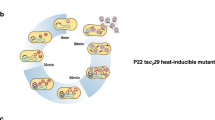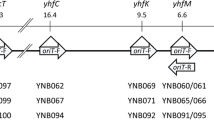Summary
F′ pro + plasmids were selected and used as donors to prepare P22 transducing phages. Two types of result were observed. pro + from type I donors cannot be packaged by wild-type P22 to yield transducing particles unless a prophage pac site is introduced into the plasmid. Transposon Tn10 also allows initiation of packaging. pro + from type II plasmids can be transduced with the same efficiency as pro + DNA on the chromosome, indicating that a chromosomal pac site was included when the F′ pro + was excised from the Hfr strain. The usefulness of type I plasmids as a test substrate for pac signals is discussed.
Similar content being viewed by others
References
Bochner BR, Huang H, Schieven G, Ames B (1980) A positive selection for the loss of tetracycline resistance and its use in bacterial genetics. J Bact 143:926–933
Casjens S, Huang WM (1982) Initiation of sequential packaging of bacteriophage P22 DNA. J Mol Biol 157:287–298
Chan RK, Botstein D (1972) Genetics of bacteriophage P22. I. Isolation of prophage deletions which affect immunity to superinfection. Virology 49:257–267
Chelala CA, Margolin P (1976) Evidence that HT mutant strains of bacteriophage P22 retain an altered form of substrate specificity in the formation of transducing particles in Salmonella typhimurium. Genet Res 27:315–322
Ebel-Tsipis J, Botstein D, Fox MS (1972) Generalized transduction by phage P22 in Salmonella typhimurium. I. Molecular origin of transducing DNA. J Mol Biol 71:433–448
Feiss M, Fisher RA, Siegele DA, Nichols BP, Donelson JE (1979) Packaging of the bacteriophage lambda chromosome: A role for base sequences outside cos. Virology 92:56–67
Jackson EN, Jackson DA, Deans RJ (1978) EcoRI analysis of bacteriophage P22 DNA packaging. J Mol Biol 118:365–388
Jackson EN, Laski F, Anders C (1982) Bacteriophage P22 mutants that alter the specificity of DNA packaging. J Mol Biol 154:551–563
Kleckner N (1981) Transposable elements in prokaryotes. Ann Rev Genet 15:341–404
Kufer B, Backhaus H, Schmieger H (1982) The packaging initiation site of phage P22. Analysis of packaging events by transduction. Mol Gen Genet 187:510–515
Schmieger H (1968) Die molekulare Struktur transduzierender Partikel beim Salmonella-Phagen P22. I. Dichtegradienten-Untersuchungen an intakten Phagen. Mol Gen Genet 102:336–347
Schmieger H (1982) Phage P22 mutants with increased or decreased transduction abilities. Mol Gen Genet 119:75–88
Schmieger H (1982) Packaging signals for phage P22 on the chromosome of Salmonella typhimurium. Mol Gen Genet 187:516–518
Streisinger G, Emrich J, Stahl MM (1967) Chromosome structure in phage T4. III. Terminal redundancy and length determination. Proc Natl Acad Sci USA 57:292–295
Tye BK (1976) A mutant of phage P22 with randomly permuted DNA. J Mol Biol 100:421–426
Author information
Authors and Affiliations
Additional information
Communicated by H. Saedler
Rights and permissions
About this article
Cite this article
Schmieger, H. pac sites are indispensable for in vivo packaging of DNA by phage P22. Mol Gen Genet 195, 252–255 (1984). https://doi.org/10.1007/BF00332755
Received:
Issue Date:
DOI: https://doi.org/10.1007/BF00332755




